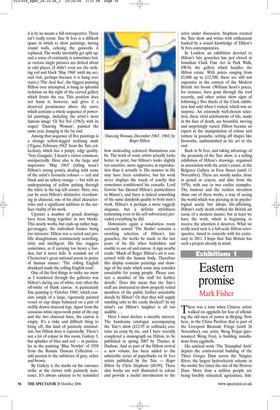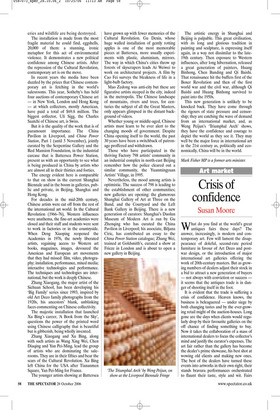Eastern promise
Mark Fisher
There was a time when Chinese artists walked on eggshells for fear of offending the old men of power in Beijing. Now here, in the China Pavilion that is part of the Liverpool Biennale Fringe (until 26 November), one artist, Weng Peijun (pronounced Weng Fen), is building installations from eggshells.
His satirical work ‘The Triumphal Arch’ depicts the controversial building of the Three Gorges Dam across the Yangtze River, the largest hydroelectric scheme in the world, five times the size of the Hoover Dam. More than a million people are being forcibly relocated; agriculture, fish eries and wildlife are being destroyed.
The installation is made from the most fragile material he could find, eggshells, 20,000 of them: a stunning, ironic metaphor for this act of environmental violence. It demonstrates a new political confidence among Chinese artists. After the repression of the Cultural Revolution, contemporary art is on the move.
In recent years the media have been dazzled by the prices that Chinese contemporary art is fetching in the world’s salesrooms. This year, Sotheby’s has held four auctions of contemporary Chinese art — in New York, London and Hong Kong — at which collectors, mostly American, have paid a total of $69.8 million. The biggest collector, Uli Sigg, the Charles Saatchi of Chinese art, is Swiss.
But it is the quality of the work that is of paramount importance. The China Pavilion in Liverpool, and China Power Station, Part 1 (until 5 November), jointly curated by the Serpentine Gallery and the Red Mansion Foundation, in the industrial carcase that is Battersea Power Station, present us with an opportunity to see what is being produced in China by artists who are almost all in their thirties and forties.
The energy evident here is comparable to that on show in the current Shanghai Biennale and in the boom in galleries, public and private, in Beijing, Shanghai and Hong Kong.
For decades in the mid-20th century, Chinese artists were cut off from the rest of the international art world. In the Cultural Revolution (1966–76), Western influences were anathema, the fine-art academies were closed and their staff and students were sent to work in factories or in the countryside. When Deng Xiaoping reopened the Academies in 1976, the newly liberated artists, regaining access to Western art books, magazines, images, devoured the American and European art movements that they had missed: film, video, photography; installation, performance, mixed media; interactive technologies and performance. The techniques and technologies are international, but the work is deeply Chinese.
Zhang Xiaogang, the major artist of the Sichuan School, has been developing his ‘Big Family’ series since 1993, inspired by old Art Deco family photographs from the 1920s, his ancestors’ blank, unblinking faces commenting on Chinese collectivity.
The majestic installation that launched Xu Bing’s career, ‘A Book from the Sky’, questions the power of the printed word using Chinese calligraphy that is beautiful but is gibberish, being wholly invented.
Zhang Xiaogang and Xu Bing, along with such artists as Wang Xing Wei, Chen Diaqing and Yan Pei-Ming, lead the group of artists who are dominating the salerooms. They are in their fifties and bear the scars of the Cultural Revolution. Xu Bing left China for the USA after Tiananmen Square, Yan Pei-Ming for France.
The younger artists showing at Battersea have grown up with fewer memories of the Cultural Revolution. Gu Dexin, whose huge walled installation of gently rotting apples is one of the most memorable pieces at Battersea, more usually experiments with plastic, aluminium, mirrors. The way in which China’s cities throw up forests of skyscrapers leads Ai Weiwei to work on architectural projects. A film by Cao Fei surveys the bleakness of life in a light-bulb factory.
Mao Zedong was anti-city but these are figurative artists steeped in the city, indeed in the metropolis. The Chinese landscape of mountains, rivers and trees, for centuries the subject of all the Great Masters, only appears glimpsed in the distant background of videos.
Whether young or middle-aged, Chinese artists must learn to be ever alert to the changing moods of government. Despite China opening itself to the world, the past 30 years have been a switchback of patronage proffered and withdrawn.
Those who have participated in the thriving Factory 798 artists’ community in an industrial complex in north-east Beijing remember how the police cleared out a similar community, the Yuanmingyuan Artists’ Village, in 1995.
Nevertheless, the mood among artists is optimistic. The success of 798 is leading to the establishment of other communities; new galleries are opening: the glamorous Shanghai Gallery of Art at Three on the Bund, and the Courtyard and the Left Bank Gallery in Beijing. There is a new generation of curators: Shanghai’s Duolun Museum of Modern Art is run by Gu Zhenqing who has curated the China Pavilion in Liverpool; his associate, Biljana Ciric, has contributed an essay to the China Power Station catalogue; Zhang Wei, trained at Goldsmith’s, curated a show at Frieze in London and is about to open a new gallery in Beijing. The artistic energy in Shanghai and Beijing is palpable. This great civilisation, with its long and glorious tradition in painting and sculpture, is expressing itself again, in a way not dissimilar to the late19th century. Then exposure to Western influences, after long hibernation, released a great generation of painters, Huang Binhong, Chen Banding and Qi Baishi. That renaissance hit the buffers first of the Boxer Revolution and then of the first world war and the civil war, although Qi Baishi and Huang Binhong survived to paint into the 1950s.
This new generation is unlikely to be knocked back. They have come through the rigours of state pressure and censorship; they are catching the wave of demand from an international market, and, as Weng Peijun’s ‘Triumphal Arch’ shows, they have the confidence and courage to depict the world as they see it. They may well be the major force in international art in the 21st century as, politically and economically, China will be in the world.



























































































 Previous page
Previous page